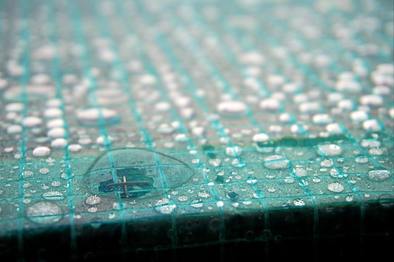|
Contributed by Dean Moilanen The finishing trades most often come into play at the end of the construction project. In many cases, the end result is decorative, ornamental, and breathes life into the vision of the finished project. The installation of ceramic tile and natural stone is a finishing trade which must deliver on an aesthetically pleasing expectation AND be a resilient, long lasting, wearing surface. Unfortunately, all too often, critical installation methods and standards are not followed, with the end result culminating in failure.
Ironically, this uptick in installation failure comes at a time when the combined forces of the tile and stone industry are proactively reaching out to offer training and certification for contractors and installers. The National Tile Contractors Association (NTCA), The Ceramic Tile Education Foundation (CTEF), and Advanced Certifications for Tile Installers (ACT) are just some of the organizations offering comprehensive education and training. The downturn in the construction industry, which occurred during the last recession, saw a vast outflow of qualified installers from the industry. The challenge still remains to locate and train individuals to address the demands of a rebounding trade. This challenge has played a role in some of the nagging failure issues that continue to occur. These failures are based more on a lack of installer knowledge and competence, then deliberate shoddy practices. Simply put, yes, you “really have to do that”, follow the ANSI or ASTM standard that is, if you want to steer clear of problems and failures. Listed below are just two of the concerns which need to be addressed in today’s ceramic tile and stone industry. If there is one overwhelming area of concern when it comes to the success or failure of a tile or stone installation, it would be the adequate bonding of the tile or stone to the substrate. ANSI A108.5-2.2.2 outlines the process of achieving the coverage needed to bond tile or stone to the wall or floor substrate. Summarized, the adhesive used to bond the tile or stone must be applied uniformly and evenly to the substrate; no “rainbow arches of adhesive”, no “five spotting” or daubs of adhesive placed in irregular fashion on the substrate, serving as “targets” for bonding of tile. Minimum coverage required (the amount of bonding agent affixed to the underside of the tile) can range from 80% in “dry” areas to 95% in wet areas. Wet area bonding has heightened concern, as any voids in the setting bed can serve to trap moisture and result in microbial growth (mold). The lack of adequate bond between the substrate and tile or stone finished surfaces is the culprit in all too many failures. Wet area waterproofing concerns continue to plague tile and stone installations as well. Of growing concern is the need for tile and stone shower detail to withstand vapor migration, as steam/vapor (resulting from shower usage) migrates to behind the tiled shower wall. The moisture damages the interior wall details and oftentimes finds a food source that contributes to mold. ASTM E96 Procedure E is a performance standard for waterproof membrane systems, which when called out in specifications ensures a “steam room” level of performance on the shower walls of these wet areas. Typically, the products meeting this standard are applied to the outer face of a suitable wall substrate in shower details, with the tile then bonded to the membrane. When assessing the viability of product to be used with regard to this ASTM standard, be sure to source independent third party testing for validating a product’s performance claims. There is now language and documentation available to architects and specification writers which calls for qualified labor, and is available from the National Tile Contractors Association. Implementation of this language would aid industry efforts to improve installation quality.
5 Comments
Issa
11/2/2018 07:55:45 pm
Very informative! I have tile floors so I should to keep my floors clean at all cost, other wise, the floors start to stain. However, since I have 4 kids and work, I’m unable. I have found that <b><a href="https://thetopcleaner.com/top-saginaw-tile-cleaning/"title="The Top Cleaner">The Top Cleaner</a></b> is a website that has helped me find the best companies to clean my floors!
Reply
Issa
11/2/2018 07:56:58 pm
Very informative! I have tile floors so I should to keep my floors clean at all cost, other wise, the floors start to stain. However, since I have 4 kids and work, I’m unable. I have found that https://thetopcleaner.com/top-saginaw-tile-cleaning/ is a website that has helped me find the best companies to clean my floors!
Reply
8/1/2019 03:41:59 am
I really appreciate your hard work for bringing this useful article thank you for sharing this useful information.
Reply
2/16/2023 09:06:17 pm
Thank you for sharing this wonderful article. Very efficiently written information. It will be useful to anybody who utilizes it when it comes to tile intallation. Keep up the good work.
Reply
5/9/2023 10:54:39 pm
Thank you for sharing the blog post on critical tile installation methods and standards. I found the article to be an informative and valuable resource for anyone involved in the tile installation process. I appreciate the in-depth discussion on different installation techniques, such as mortar bed, thin-set, and large-format tile installation. The explanations provided for each method, along with their advantages and considerations, offer valuable insights for both professionals and DIY enthusiasts.
Reply
Leave a Reply. |
AboutLet's Fix Construction is an avenue to offer creative solutions, separate myths from facts and erase misconceptions about the architecture, engineering and construction (AEC) industry. Check out Cherise's latest podcast
Get blog post notifications hereArchives
March 2022
Categories
All
|


 RSS Feed
RSS Feed
